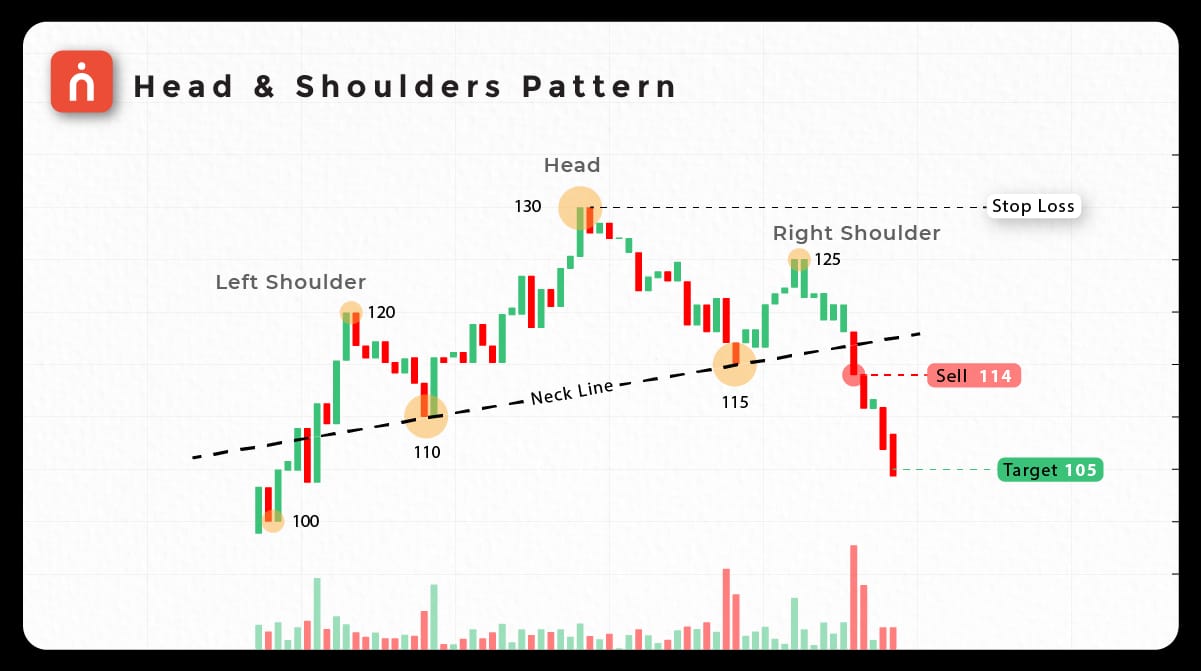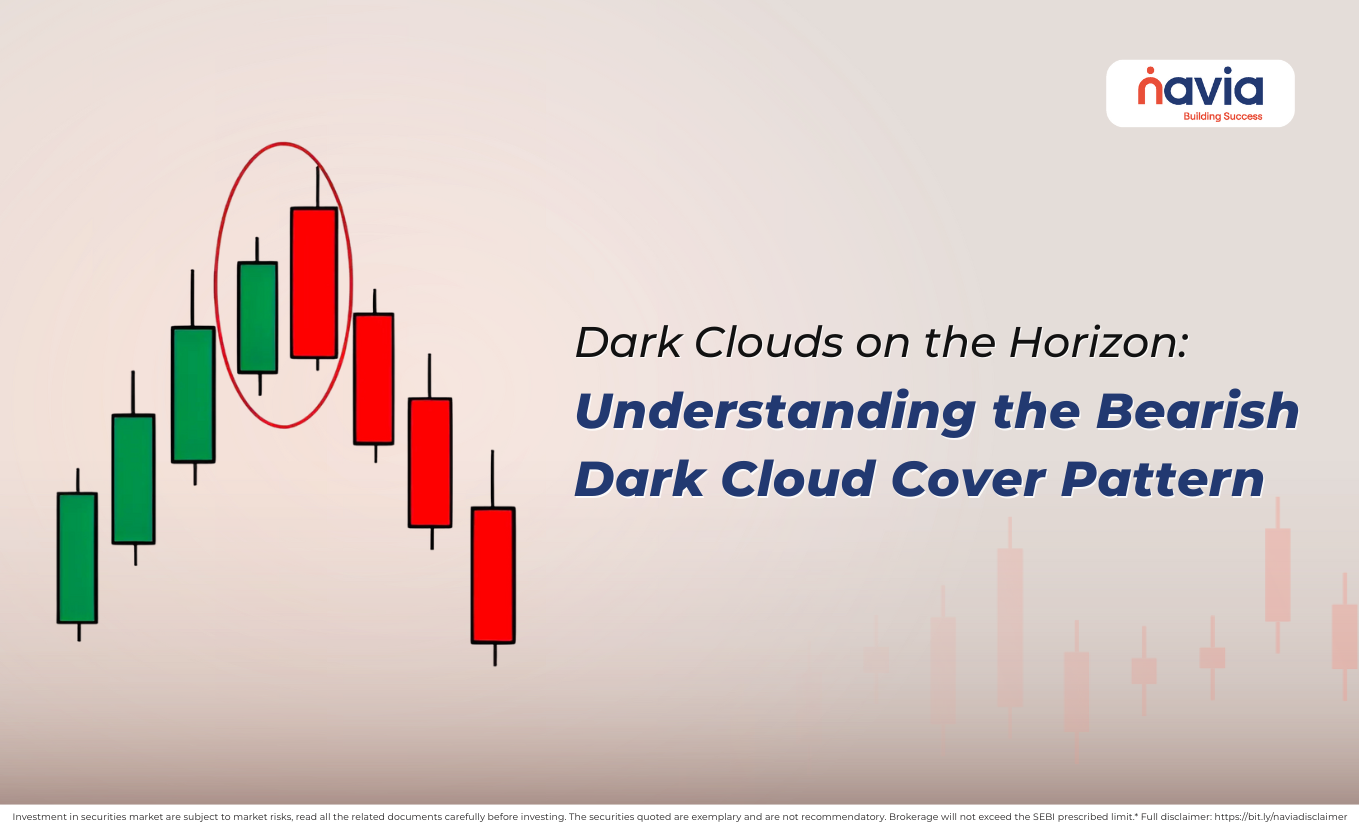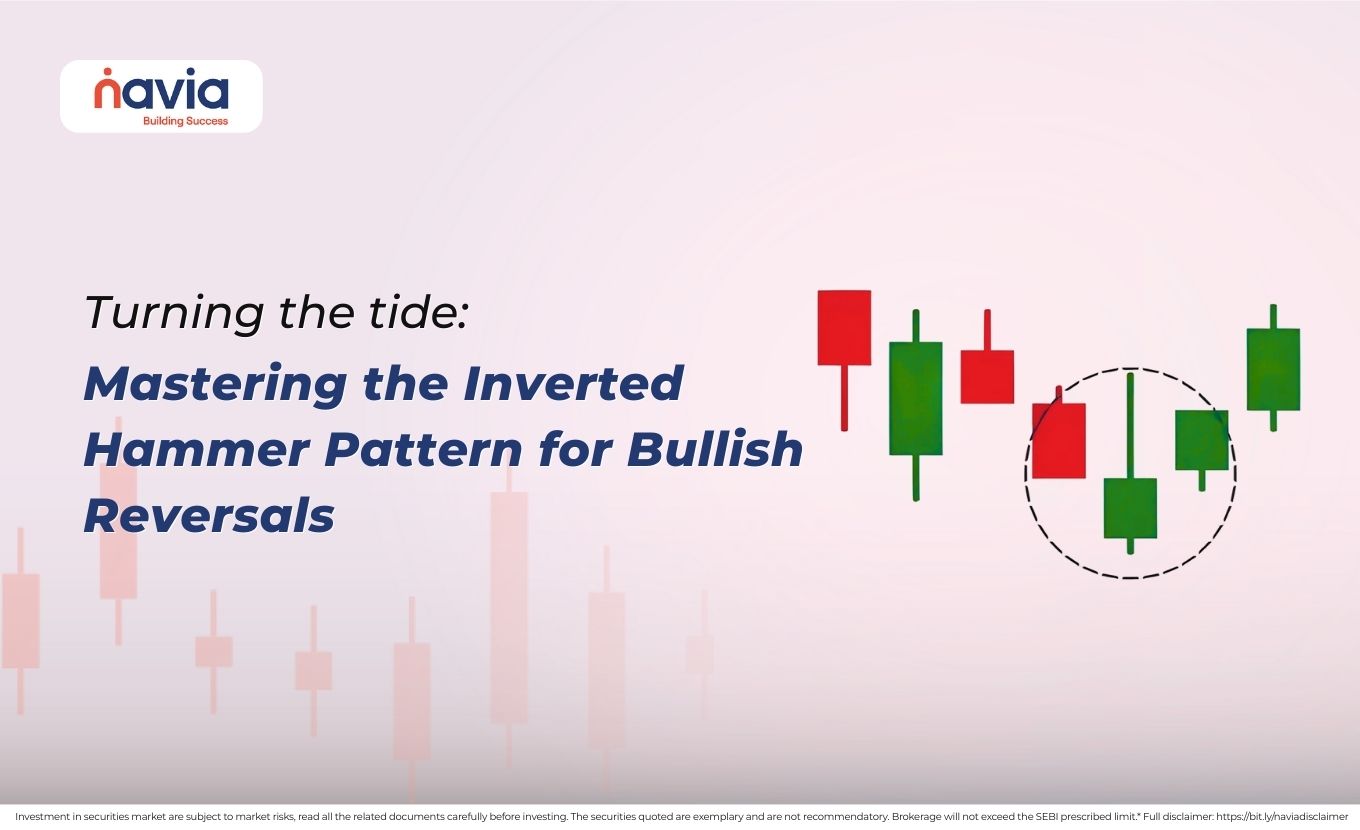Understanding the Head and Shoulders Chart Pattern: A Guide for Traders

Chart patterns are essential tools in technical analysis, helping traders identify potential market reversals and continuations. Among these patterns, the Head and Shoulders is one of the most reliable and widely recognized formations. It is often seen as a reversal pattern, signaling that a trend is likely coming to an end. In this blog, we will break down the Head and Shoulders pattern, explain the math and psychology behind it, and show you how to effectively use this pattern in your trading strategy. We will also provide examples in a tabular form and discuss how to use the Navia Mobile App for analyzing chart patterns.
What is a Head and Shoulders Pattern?
The Head and Shoulders pattern is a chart formation that resembles a baseline with three peaks: a higher peak in the middle (the “head”) and two lower peaks on either side (the “shoulders”). This pattern typically forms after an uptrend and signals a potential reversal to the downside. It indicates that the momentum is shifting from bullish to bearish, with sellers starting to overpower buyers.
There is also an Inverse Head and Shoulders pattern, which is the opposite of the standard Head and Shoulders. It forms after a downtrend and signals a potential reversal to the upside.
The Structure of a Head and Shoulders Pattern
The Head and Shoulders pattern consists of the following components:
1. Left Shoulder: The price rises to a peak and then declines to form a trough.
2. Head: The price rises again, forming a higher peak than the Left Shoulder, and then declines.
3. Right Shoulder: The price rises once more, but to a lower peak than the Head, and then declines.
4. Neckline: A trendline drawn connecting the troughs formed between the Head and the Shoulders. The neckline acts as a support level in a Head and Shoulders pattern and as a resistance level in an Inverse Head and Shoulders pattern.
The Math Behind the Head and Shoulders Pattern
The Head and Shoulders pattern is based on simple price action. Here’s how the math works:
🔷 Left Shoulder: The initial peak (Left Shoulder) forms when buying pressure drives the price up. This is followed by a decline as selling pressure increases.
🔷 Head: The price rallies again, this time reaching a higher peak (the Head). However, the subsequent decline is more pronounced, reflecting a shift in market sentiment.
🔷 Right Shoulder: The final rally fails to reach the height of the Head, forming the Right Shoulder. This failure to reach a new high indicates that buyers are losing control, and a reversal is likely.
🔷 Neckline: The neckline is the key support level. When the price breaks below the neckline, it confirms the pattern and signals a potential downward move.
Psychology Behind the Head and Shoulders Pattern
The Head and Shoulders pattern represents a shift in market sentiment:
🔶 Left Shoulder: The market is still bullish, but the first signs of selling pressure emerge.
🔶 Head: The bullish sentiment peaks, but increased selling pressure leads to a deeper decline.
🔶 Right Shoulder: The market attempts to rally again, but fails to reach the previous high, indicating weakening buying interest.
🔶 Break of the Neckline: When the price breaks below the neckline, it signals that the sellers have taken control, and the trend is likely to reverse.
How to Identify a Head and Shoulders Pattern
To identify a Head and Shoulders pattern on a chart, look for the following characteristics:
1. Three Peaks: The pattern should have three distinct peaks, with the middle peak (Head) being the highest and the other two peaks (Shoulders) being lower and roughly equal in height.
2. Neckline: Draw a trendline connecting the two troughs between the Head and the Shoulders. This is the neckline.
3. Break of the Neckline: A break below the neckline confirms the pattern and signals a potential reversal.
Example of a Head and Shoulders Pattern
Let’s consider a practical example to illustrate this pattern:
| Stage | Price Movement | Description |
| Left Shoulder | ₹100 → ₹120 → ₹110 | The price rises to ₹120 (Left Shoulder) and then falls to ₹110. |
| Head | ₹110 → ₹130 → ₹115 | The price rises to ₹130 (Head) and then falls to ₹115. |
| Right Shoulder | ₹115 → ₹125 → ₹115 | The price rises to ₹125 (Right Shoulder) and then falls to ₹115. |
| Neckline Break | ₹115 → ₹105 | The price breaks below the neckline at ₹115 and falls to ₹105, confirming the pattern. |
Explanation:
🔷 The Left Shoulder forms when the price reaches ₹120 and then declines to ₹110.
🔷 The Head forms as the price rallies to ₹130, but then declines to ₹115.
🔷 The Right Shoulder forms as the price fails to reach the Head’s height, peaking at ₹125 before declining again to ₹115.
🔷 The neckline, drawn at ₹115, is broken when the price falls to ₹105, confirming the pattern and signaling a potential bearish reversal.
How to Use the Head and Shoulders Pattern in Trading
The Head and Shoulders pattern is most effective when used as a reversal signal. Here’s how to use this pattern in your trading strategy:
1. Wait for Confirmation: The pattern is not complete until the price breaks below the neckline. Wait for this confirmation before entering a trade.
2. Enter a Short Position: Once the neckline is broken, consider entering a short position. The break below the neckline confirms that the bearish reversal is likely to occur.
3. Set a Stop-Loss: Place a stop-loss order above the Right Shoulder or the Head to protect against false signals.
4. Target Price: The expected price movement after the neckline break can be estimated by measuring the distance from the Head to the neckline and projecting it downward from the neckline.
Practical Trading Strategy Using Head and Shoulders
Here’s a simple trading strategy that incorporates this pattern:
1. Identify the Pattern: Spot the Head and Shoulders pattern on a price chart.
2. Wait for the Neckline Break: Confirm the pattern by waiting for the price to break below the neckline.
3. Enter a Short Position: Short the asset when the neckline is broken.
4. Set a Stop-Loss: Place a stop-loss above the Right Shoulder or Head.
5. Take Profit: Estimate the price target by measuring the distance from the Head to the neckline and projecting it downward from the neckline.
Example of a Head and Shoulders Trading Strategy
| Step | Action | Price Level |
| Identify Pattern | Spot Head and Shoulders at ₹125 | ₹125 |
| Wait for Confirmation | Wait for neckline break at ₹115 | ₹115 |
| Enter Short Position | Sell at ₹114 | ₹114 |
| Set Stop-Loss | Stop-loss at ₹130 (above Head) | ₹130 |
| Take Profit | Target price at ₹105 | ₹105 |
Inverse Head and Shoulders Pattern
The Inverse Head and Shoulders pattern is the bullish counterpart to the standard Head and Shoulders. It forms after a downtrend and signals a potential reversal to the upside. The structure is the same, but flipped:
1. Left Shoulder: Price declines, forms a trough, and then rises.
2. Head: Price declines further to form a lower trough, then rises again.
3. Right Shoulder: Price declines again, but not as low as the Head, forming the Right Shoulder, then rises.
4. Neckline Break: A break above the neckline confirms the pattern and signals a potential upward move.
How to Use Navia Mobile App for Analyzing Chart Patterns
The Navia Mobile App is a powerful tool for traders looking to analyze chart patterns, including the Head and Shoulders. Here’s how you can use the app to enhance your trading decisions:
1. Real-Time Charting Tools: Navia Mobile App offers real-time charting tools that allow you to easily spot patterns like the Head and Shoulders. You can customize your charts with different time frames and indicators.
2. Pattern Recognition: Use the app’s pattern recognition features to automatically identify key patterns, saving time and ensuring you don’t miss critical signals.
3. Backtesting Strategies: The app allows you to backtest your strategies based on historical data, helping you refine your approach and see how the Head and Shoulders pattern has performed in the past.
4. Risk Management Tools: Navia’s built-in risk management tools help you set stop-loss and take-profit levels based on your strategy, ensuring that you manage your risk effectively.
Summary Table: Head and Shoulders Pattern at a Glance
| Feature | Description |
| Shape | Three peaks, with the middle peak (Head) being the highest and the two side peaks (Shoulders) being lower |
| Signal | Bearish reversal, typically appears after an uptrend |
| Psychology | Indicates that the buying pressure is weakening and sellers are gaining control |
| Best Use | Most effective at the top of an uptrend, signals potential reversal |
| Confirmation Needed | Wait for a break of the neckline before entering a trade |
| Risk Management | Use stop-loss orders above the Right Shoulder or Head to protect against false signals |

Conclusion
The Head and Shoulders pattern is a powerful tool for traders looking to identify potential market reversals. By understanding the math and psychology behind this pattern, and combining it with other technical indicators and confirmation signals, traders can make more informed decisions and improve their trading strategies. The Navia Mobile App further enhances your ability to analyze and act on chart patterns, providing you with the tools and real-time data necessary for successful trading.
Whether you’re a beginner or an experienced trader, mastering the Head and Shoulders pattern and incorporating it into your trading strategy can help you navigate the markets more effectively and achieve your financial goals. Happy trading!
We’d Love to Hear from you-
DISCLAIMER: Investments in the securities market are subject to market risks, read all the related documents carefully before investing. The securities quoted are exemplary and are not recommendatory. Brokerage will not exceed the SEBI prescribed limit.





